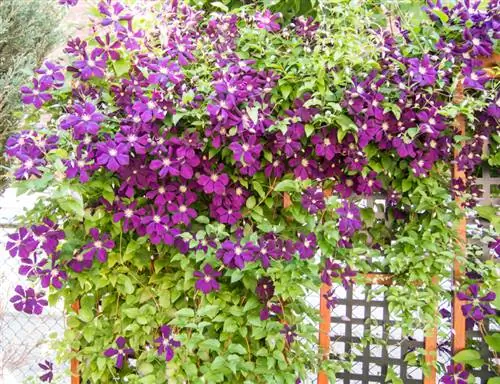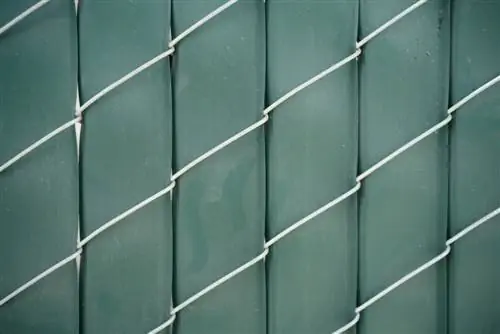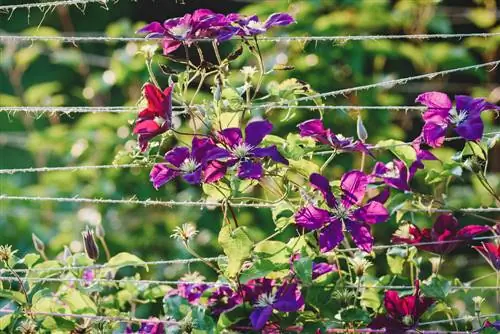- Author admin [email protected].
- Public 2023-12-16 16:46.
- Last modified 2025-01-23 11:20.
The clematis does not have any adhesive organs, but rather tends towards the sky with its strong petioles. This means that the clematis only functions as a climbing facade greenery if it is offered a climbing aid. Read here how you can easily build a trellis yourself.

How do I build a clematis trellis for facade greening?
Building a clematis trellis for facade greening requires wooden posts, wooden boards, trellis anchors, tapping screws as well as a hammer, cordless screwdriver and drill. The battens must be adapted to the Clematis species and the assembly is carried out in a grid-like arrangement.
Material and tool list
In nature-loving hobby gardens, wood is very popular as a building material for climbing aids. Types of wood such as oak, larch, chestnut or noble robinia are suitable. In addition, all softwoods are suitable for the espalier of a clematis. These materials and tools are required:
- Wooden posts as cross bars in 25 x 25 or 30 x 30 mm thickness
- Wooden boards for the trellis battens
- Trellis anchors for wall mounting
- Tapping screws
- Hammer, cordless screwdriver and drill
The wall anchors should be long enough to allow a sufficient distance of 6-10 cm between the clematis and the wall so that air can circulate freely. If you decide on a distance of 5 cm from the wall, this requires removing the tendrils that grow behind it every year.
Clematis species defines the battens on the trellis
Within the diverse Clematis family, species and varieties with a wide variety of petiole lengths are represented. Therefore, match the spacing of the wooden slats to the chosen clematis. A mighty Clematis montana is quite capable of encompassing a slat with a diameter of up to 9 cm. Smaller varieties, such as Clematis texensis, are delicate and require a correspondingly narrower climbing aid.
As a petiole tendril, the clematis generally prefers a trellis in a grid-like arrangement. Please follow these steps when building:
- Depending on the height of the wall, attach 2, 3 or more strong crossbars using the trellis anchors
- Indent the anchors 20-30 cm so that they remain invisible
- Fix the wooden slats vertically with the tapping screws
Please note the special regulations for attaching a trellis to facades with insulation. In this case, special spacing systems are used, such as support bodies, which must first be attached with a cylinder drill. Only then is the trellis anchor attached to the supporting substrate.
Tips & Tricks
Have the profiles of wooden crossbars beveled slightly at the hardware store. This trick prevents the formation of standing water and reduces the risk of fungal infections on the clematis.






